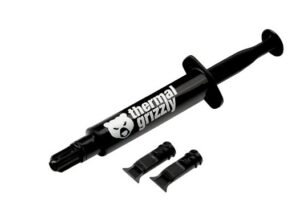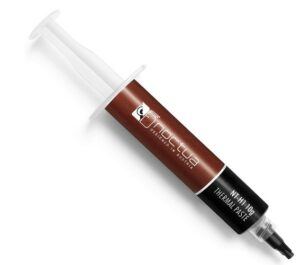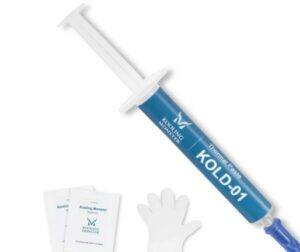Most steps to building your desktop PC are self-explanatory: thanks to the modular nature of PC parts, it’s really hard to mess with. But there is one exception, and it can be messy.
Thermal paste (also called thermal grease, thermal interface material, or thermal gel) is a semi-fluid compound that you apply to the metal housing of the CPU to allow efficient heat transfer to the cooler mounted above it.
Coins And if you’ve never used it before, it can be hard to know how much you need – and the internet is full of bad advice. Before we begin: The thermal paste is applied to the top of the CPU, not the bottom.
You should apply it to a smooth metal plate (where manufacturer and model information is printed), not to hundreds of squares or pins at the bottom.
Thermal paste does not go directly to the CPU socket of the motherboard. This point may seem obvious to the experienced system builder, but it is a mistake often made by first-timers, which can, unfortunately, ruin an expensive CPU (and motherboard).
When it reaches thermal paste, less is more.
The thermal paste helps transfer heat between the CPU and the installed cooler so that a better method may be known. But not so with thermal compounds.
People may not realize this before installing a heat sink: This metal slab will be closed with a certain amount of pressure on the CPU.
This socket locking mechanism will force the thermal paste under pressure and spread to the outer edges of the CPU.
If you apply too much paste, it will crack and stick to the motherboard. If you can look around the socket, it will not only look dirty, but it will also be difficult to get rid of when you switch out the cooler.
There is even a chance that, in extreme cases, it could cause power outages and overheat. Even component manufacturers insist on a more controlled application of thermal compounds.
Apply the right amount of compound
So, how much thermal paste do we recommend? A small bulb of goods will do. Examine the size of a small garden pea you can boil for dinner.
You want to aim at the center of the CPU, approximately the same size, which will spread evenly over the top when the heat sink is installed.
Some compound packaging may also come with a handy tool that allows you to spread the paste evenly across the CPU.
If you don’t have one, the heat sink usually works fine, as long as you apply pressure when installing the cooler so that all the compounds don’t come out of one corner.
If you somehow manage to apply too much, use some alcohol and paper towels to clean the CPU before reapplying the compound.
If you follow the garden pea technique, you will have a solid thermal compound spread each time.
Bottom line: Don’t apply a ton of thermal paste. Think more paste and get better results. There is more or less in this scenario.
How much thermal paste should I use on the CPU?
I have a small Arctic Silver 3.5G tube in my desk drawer that I paid $5.95 five years ago, and it’s probably still half full. It works well, but not better than any other paste I’ve used.
Three years ago, I picked up a 30-gram tube of so-called GD900 sugar paste, which got good reviews.
I may have paid $ 3.95 for this gigantic tube of the goop, and although it is messy with poor mixing, it works great. A similar amount of thermal grizzly crayonate is $ 76.
I wouldn’t blame anyone for buying better quality products for their high-performance computers, especially servers or hot CPUs like 10900K 12900K.
A reasonably priced GOP 4G tube like the Arctic MX-4, NT-H1, or Zalman STC8 costs about $ 7.99. Silver is still selling at 50 4.50 on Navig and, in my opinion, is still the best you can buy.
For people who change their CPU too much, the goop I bought on eBay is being sold on Amazon under the name LINASHI.
The 30-gram tube is $ 1.73 with a $ 2.99 shipping fee. Again, not as good as Arctic Silver or Thermal Grizzly, but it works. I tested the 4-core / 8-third Xeon for an hour last week with a modest tower cooler, and the CPU temperature remained at 34 ° C the whole time.
For a low-powered CPU, you don’t need anything. You may want to guarantee long-term sustainability with a CPU that operates above 100W.
Here is some premium quality thermal past that you need:
| IMAGE & DISC | PRICE LINK |



How to Apply Thermal Paste
One of the most common methods is the “line method.” It’s just as it seems. Apply a thin line of thermal paste directly below the center of the IHS (Integrated Heat Spreader), and then allow the pressure of the CPU cooler to spread the paste as you save it.
The problem with this method is that the paste does not spread evenly. To ensure you have enough paste to cover the entire area of the CPU, you are more likely to end up with too much paste. It negatively affects performance because excessive paste interferes with efficient heat transfer.
Pros
- Liquid metal thermal paste is much better in terms of thermal performance and can lower your temperature by 5–10 C, or in some cases, even more.
- A good thermal paste can profoundly affect your performance, as it will allow your processor to transfer its waste heat to your cooler while running cold. Choosing the best thermal paste is also important if you plan to overclock your vein completely.
Cons
- Liquid metal thermal paste is viable and can cause shorts if it gets into electrical components. It is also more expensive than ordinary thermal paste and cannot be used with aluminum heat sinks, as it will destroy them. Liquid metal thermal paste is usually unnecessary unless you need a CPU or GPU to cool down.
- If the thermal paste gets too dry, it may not be able to transfer heat properly. When this happens, the chips in your computer may not get the cooling effect they need. Therefore, in these rare cases, a “bad” or very dry thermal paste may fail to suppress the heat, causing it to accumulate in the chips.
Final Thought
Thermal grease is meant exclusively for plugging minor crevices in the surface of the heat sink and CPU heat spreader.
As indicated, a drop the size of a pea or smaller is an adequate quantity of TIM. A 3.5-gram tube will be adequate for at least (20) CPUs.

